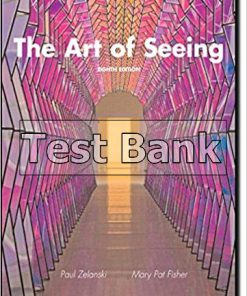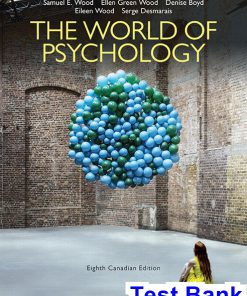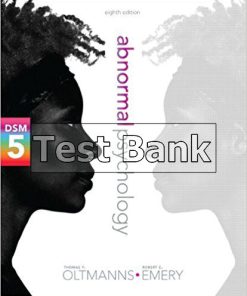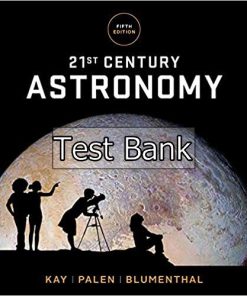World of Art 8th Edition Sayre Test Bank
You may also like
-
$26.50
$50.00
This is completed downloadable of World of Art 8th Edition Sayre Test Bank
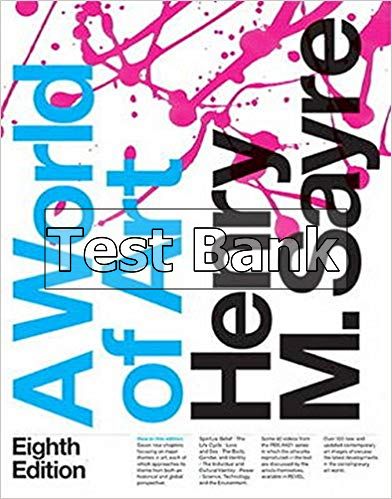
Product Details:
- ISBN-10 : 0134082265
- ISBN-13 : 978-0134082264
- Author: Henry M. Sayre
A World of Art fosters the critical thinking and visual literacy skills students need to understand art from around the globe. Noted author and educator Henry Sayre teaches students how to ask the right questions about the visual world that surrounds us, and to then respond meaningfully to the complexity of that world. New to the eighth edition, seven thematic chapters help students better identify and understand major themes of art—such as “the cycle of life” and “the body, gender, and identity”—that transcend different eras and regions.
Table of Content:
- Group 1 The Visual World
- Chapter 1 Discovering a World of Art
- Learning Objectives
- The World as We Perceive It
- The Process of Seeing
- Active Seeing
- The World as Artists See It
- The Creative Process
- Art and the Idea of Beauty
- Roles of the Artist
- 1) Artists Make a Visual Record of the People, Places, and Events of their Time and Place
- 2) Artists Help Us to See the World in New or Innovative Ways
- 3) Artists Make Functional Objects and Structures (Buildings) More Pleasurable and Elevate Them or Imbue Them with Meaning
- 4) Artists Give Form to the Immaterial— Hidden or Universal Truths, Spiritual Forces, Personal Feelings
- Seeing the Value in Art
- Artistic Value and the “Culture Wars”
- The Avant-Garde and Public Opinion
- Political Visions
- Thinking Back
- Chapter 2 Developing Visual Literacy
- Learning Objectives
- Words and Images
- Representation and Abstraction
- Form and Meaning
- Convention, Symbols, and Interpretation
- Thinking Back
- Group 2 The Formal Elements and Their Design
- Chapter 3 Line
- Learning Objectives
- Varieties of Line
- Outline and Contour Line
- Implied Line
- Qualities of Line
- Expressive Qualities of Line
- Line Orientation
- Thinking Back
- Chapter 4 Shape and Space
- Learning Objectives
- Shape and Mass
- Negative Space
- Representing Three-Dimensional Space in Two Dimensions
- Linear Perspective
- Distortions of Space and Foreshortening
- The Near and the Far
- Modern Experiments and New Dimensions
- Experiments in Photographic Space
- Experiments with Space in Painting
- Digital Space
- Thinking Back
- Chapter 5 Light and Color
- Learning Objectives
- Light
- Atmospheric Perspective
- Value: From Light to Dark
- Chiaroscuro and Modeling
- Hatching and Cross-Hatching
- Contrast: Light and Dark
- Color
- Basic Color Vocabulary
- Color Schemes
- Representational and Symbolic Uses of Color
- Symbolic Color
- Thinking Back
- Chapter 6 Texture, Time, and Motion
- Learning Objectives
- Texture
- Actual Texture
- Visual Texture
- Time and Motion
- Narratives in Art
- Seeing Over Time
- The Illusion of Movement
- Time-Based Media
- Thinking Back
- Chapter 7 The Principles of Design
- Learning Objectives
- Balance
- Symmetrical Balance
- Asymmetrical Balance
- Radial Balance
- Emphasis and Focal Point
- Scale and Proportion
- Pattern, Repetition, and Rhythm
- Unity and Variety
- Thinking Back
- Group 3 The Fine Arts Media
- Chapter 8 Drawing
- Learning Objectives
- From Preparatory Sketch to Finished Work of Art
- Drawing Materials
- Dry Media
- Liquid Media
- Innovative Drawing Media
- Thinking Back
- Chapter 9 Painting
- Learning Objectives
- Early Painting Media
- Encaustic
- Fresco
- Tempera
- Oil Painting
- Watercolor and Gouache
- Synthetic Media
- Mixed Media
- Collage and Photomontage
- Painting beyond the Frame
- Thinking Back
- Chapter 10 Printmaking
- Learning Objectives
- The Print and Its Earliest Uses
- Relief Processes
- Woodcut
- Wood Engraving
- Linocut
- Intaglio Processes
- Engraving
- Etching
- Drypoint
- Mezzotint and Aquatint
- Lithography
- Silkscreen Printing
- Monotypes
- Thinking Back
- Chapter 11Photography and Time-Based Media
- Learning Objectives
- The Early History and Formal Foundations of Photography
- Early History
- Form and Content
- The Photographic Print and Its Manipulation
- Color and Digital Photography
- Film
- The Popular Cinema
- Video Art
- The Computer and New Media
- Thinking Back
- Chapter 12 Sculpture
- Learning Objectives
- The Three Forms of Sculptural Space
- Relief
- Sculpture In-the-Round
- Environments
- Carving
- Modeling
- Casting
- Assemblage
- Installations and Earthworks
- Installations
- Earthworks
- Art Parks
- Performance Art as Living Sculpture
- Thinking Back
- Chapter 13 The Craft Media
- Learning Objectives
- The Crafts as Fine Art
- Ceramics
- Slab Construction
- Coiling
- The Potter’s Wheel
- Porcelain
- Glass
- Fiber
- Metal
- Wood
- Thinking Back
- Chapter 14 Architecture
- Learning Objectives
- Environment
- The Impact of Climate
- “Green” Architecture
- Early Architectural Technologies
- Load-Bearing Construction
- Post-and-Lintel Construction
- Arches, Vaults, and Domes
- Modern and Contemporary Architectural Technologies
- Cast-Iron Construction
- Frame Construction
- Steel-and-Reinforced-Concrete Construction
- Community Life
- Suburbia
- Infrastructure
- Thinking Back
- Chapter 15 The Design Profession
- Learning Objectives
- The Rise of Design in the Nineteenth Century
- The Arts and Crafts Movement
- Art Nouveau
- Design in the Modernist Era
- The Modern Avant-Gardes and Design
- The Bauhaus
- Streamlining and Organic Design, 1930–60
- Design Since 1980
- Thinking Back
- Group 4 The Visual Record
- Chapter 16 The Ancient World
- Learning Objectives
- The Earliest Art
- Mesopotamian Cultures
- Egyptian Civilization
- River Valley Societies in India and China
- Complex Societies in the Americas
- Aegean and Greek Civilizations
- Aegean Cultures
- Greek Civilization
- The Roman World
- Developments in Asia
- Thinking Back
- Chapter 17 The Age of Faith
- Learning Objectives
- Early Christian and Byzantine Art
- The Rise of Islam
- Christian Art in Europe
- Carolingian Art
- Romanesque Art
- Gothic Art
- Developments in Asia
- India
- China
- Japan
- The Cultures of Africa
- Thinking Back
- Chapter 18 The Renaissance through the Baroque
- Learning Objectives
- The Renaissance
- The Early Renaissance
- The High Renaissance
- The Era of Encounter
- Art in China and Japan
- Art in Mexico and South America
- African Art of the Encounter
- The Mannerist Style in Europe
- The Baroque
- Thinking Back
- Chapter 19 The Eighteenth and Nineteenth Centuries
- Learning Objectives
- The Early Eighteenth Century
- Poussin versus Rubens
- The Rococo
- Cross-Cultural Contact: China and Europe
- Neoclassicism
- Romanticism
- Realism
- Impressionism
- Post-Impressionism
- Thinking Back
- Chapter 20 From 1900 to the Present
- Learning Objectives
- The New “Isms”
- Cubism
- Fauvism
- German Expressionism
- Futurism
- Dada and Surrealism
- Politics and Painting
- American Modernism and Abstract Expressionism
- Pop Art and Minimalism
- Cross-Fertilization in Contemporary Art
- A Plurality of Styles
- The Global Present
- Revisioning History
- Identity, Media, and the Art Market
- Thinking Back
- Group 5 The Themes of Art
- Chapter 21 Spiritual Belief
- Learning Objectives
- Connecting with Spirits and the Divine
- Giving Gods Human Form
- Sacred Space
- The Kaaba
- A Japanese Shrine
- The Hindu Pilgrimage Place
- The Pilgrimage Church
- The Native American Mission Church
- Spirituality and Abstraction
- Thinking Back
- Chapter 22 The Cycle of Life
- Learning Objectives
- Birth
- Youth and Age
- Contemplating Mortality
- Burial and the Afterlife
- Thinking Back
- Chapter 23 Love and Sex
- Learning Objectives
- Physical and Spiritual Love
- Sexuality in the Hindu World
- Eros and the Idea of Love in Ancient Greece
- A Persian Tale
- The Medieval Courtly Love Tradition
- The Privatization of Sex in the West
- Imaging Desire
- The Voyeur
- An African Festival
- Kisses
- Thinking Back
- Chapter 24 The Body, Gender, and Identity
- Learning Objectives
- The Body Beautiful
- Performance: The Body as Work of Art
- Gender and Identity
- Constructing Female Identity
- Constructing Male Identity
- Challenging Gender Identity
- Thinking Back
- Chapter 25 The Individual and Cultural Identity
- Learning Objectives
- Nationalism and Identity
- National Identity in Europe and America
- Native American Tribal History and Identity
- National Identity in China and Japan
- Class and Identity
- Marking Class
- Place and Displacement
- Racial Identity and African-American Experience
- Double Consciousness and the Great Migration
- New African-American Identities
- Thinking Back
- Chapter 26 Power
- Learning Objectives
- Representing Rulers
- Power and Might
- The Imperial Gaze
- Women and Power
- Power, Race, and the Colonial Enterprise
- The Power of the Museum
- Thinking Back
- Chapter 27 Science, Technology, and the Environment
- Learning Objectives
- Technology and the Arts
- Art and Environmental Understanding
- Nature and Industry
- Environmental Catastrophe
- Art, the Environment, and the Longer View
- Thinking Back
- The Critical Process Thinking Some More about the Chapter Questions
- Chapter 1 Andy Warhol’s Race Riot, 1963.
- Chapter 2 Two Representations of Treaty Signing at Medicine Lodge Creek.
- Chapter 3 Zeus, or Poseidon, ca. 460 bce, and Robert Mapplethorpe’s Lisa Lyon, 1982.
- Chapter 4 Isaac Julien’s Ten Thousand Waves, 2010.
- Chapter 5 Katharina Grosse’s Cincy, 2006.
- Chapter 6 Bill Viola’s Room for St. John of the Cross, 1983.
- Chapter 7 Claude Monet’s The Railroad Bridge, Argenteuil, 1874.
- Chapter 8 Frank Auerbach’s Head of Catherine Lampert VI, 1979-80.
- Chapter 9 Fred Tomaselli’s Airborne Event, 2003.
- Chapter 10 Andy Warhol’s Marilyn Monroe, 1967, and San Francisco Silverspot, 1983.
- Chapter 11 Jeff Wall’s A Sudden Gust of Wind (after Hokusai), 1993.
- Chapter 12 Christo’s Over the River, Project for the Arkansas River, State of Colorado, 2010.
- Chapter 13 Institute for Figuring, Crochet Coral Reef project, 2005-ongoing.
- Chapter 14 Taos Pueblo, 1000-1450, and Moshe Safdie’s Habitat, 1967.
- Chapter 15 Mika Tajima’s A Facility Based on Change, 2011.
- Chapter 20 Olafur Eliasson’s The Weather Project, 2003.
- Chapter 21 Bill Viola’s The Reflecting Pool, 1977-79.
- Chapter 22 Janine Antoni and Stephen Petronio’s Honey Baby, 2013.
- Chapter 23 Jan Toorop’s poster for Delftsche Slaolie, 1894.
- Chapter 24 Ana Mendieta’s Silueta Works in Mexico, 1973-77.
- Chapter 25 Dread Scott’s What Is the Proper Way to Display a U.S. Flag?, 1988.
- Chapter 26 Jenny Holzer’s Thorax, 2008.
- Chapter 27 David Brooks’s Imbroglios, 2012.
- Glossary
- Credits
- Preface
- Chapter 1
- Chapter 2
- Chapter 3
- Chapter 4
- Chapter 5
- Chapter 6
- Chapter 7
- Chapter 8
- Chapter 9
- Chapter 10
- Chapter 11
- Chapter 12
- Chapter 13
- Chapter 14
- Chapter 15
- Chapter 17
- Chapter 18
- Chapter 19
- Chapter 20
- Chapter 21
- Chapter 22
- Chapter 23
- Chapter 24
- Chapter 25
- Chapter 26
- Chapter 27
- Index
People Also Search:
world of art sayre
world of art 8th edition sayre
world of art
world of art 8th edition
world of art 8th edition download scribd
world of art 8th edition testbank download pdf

